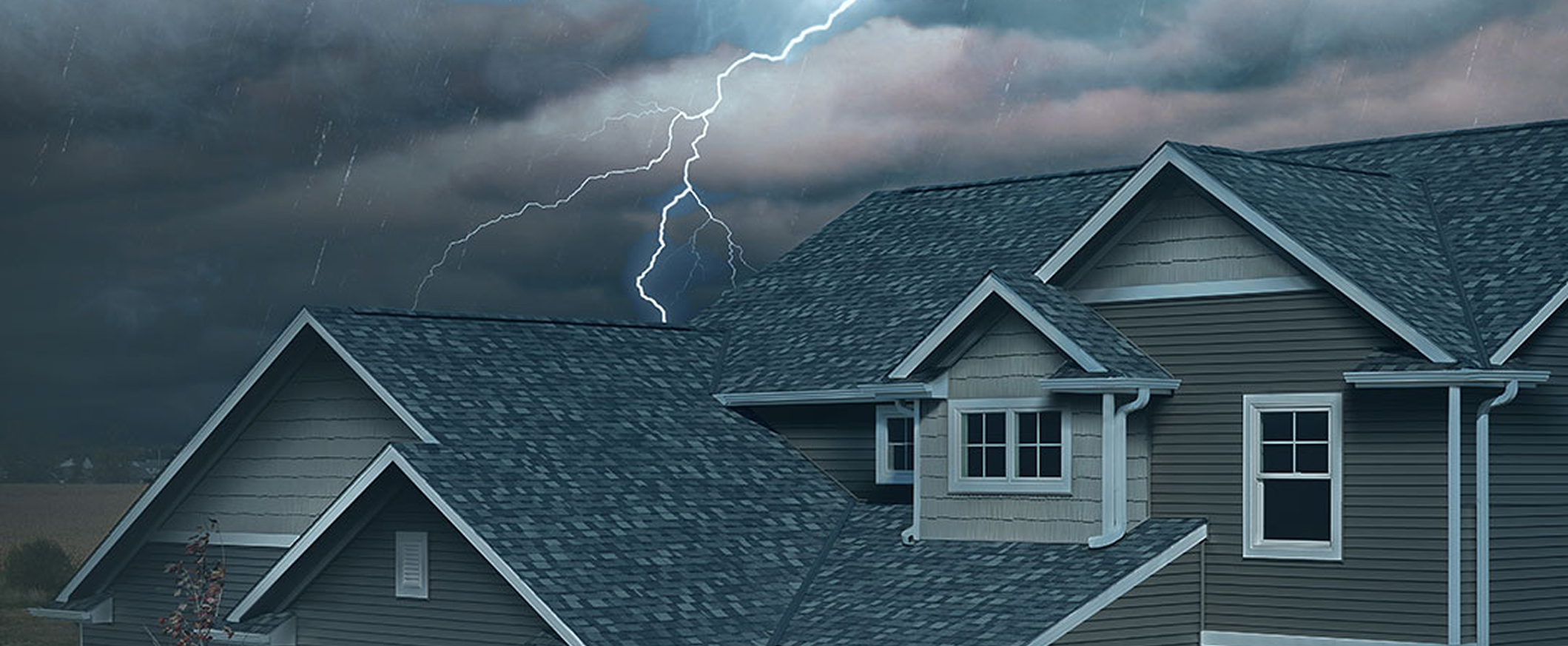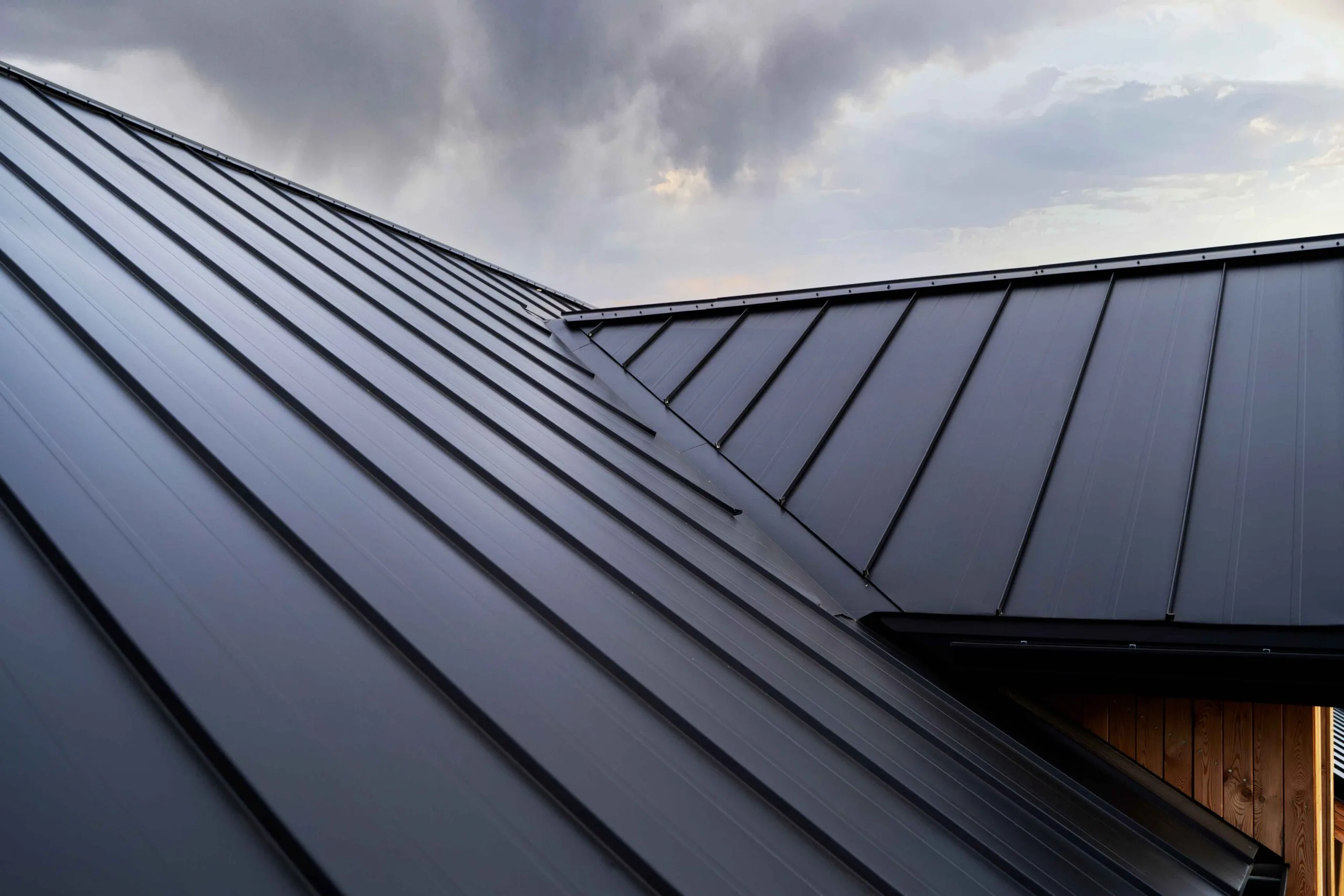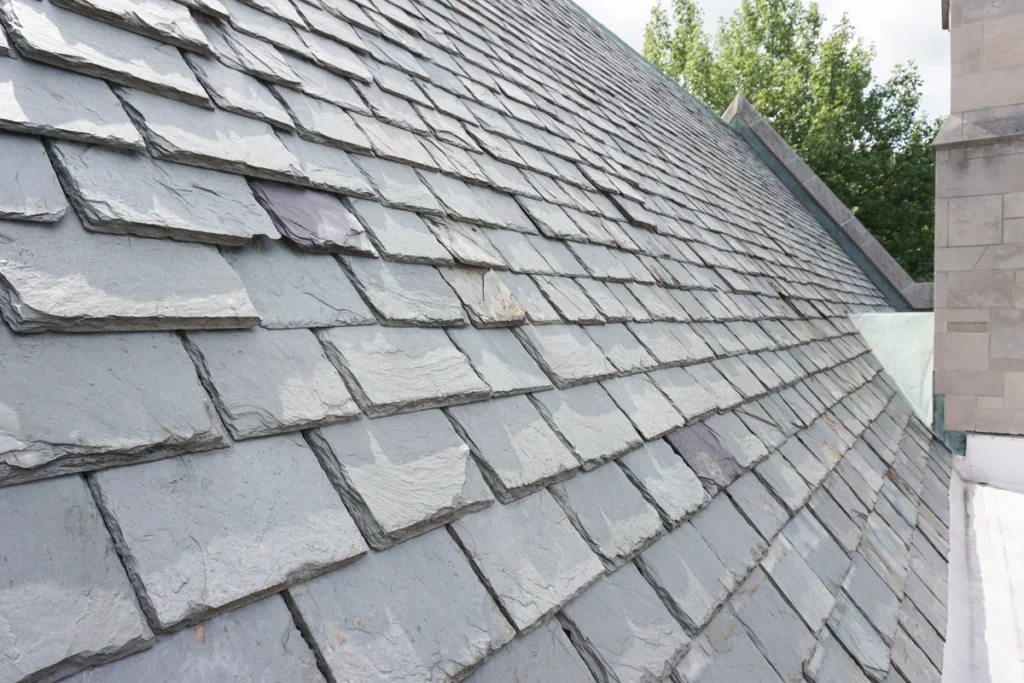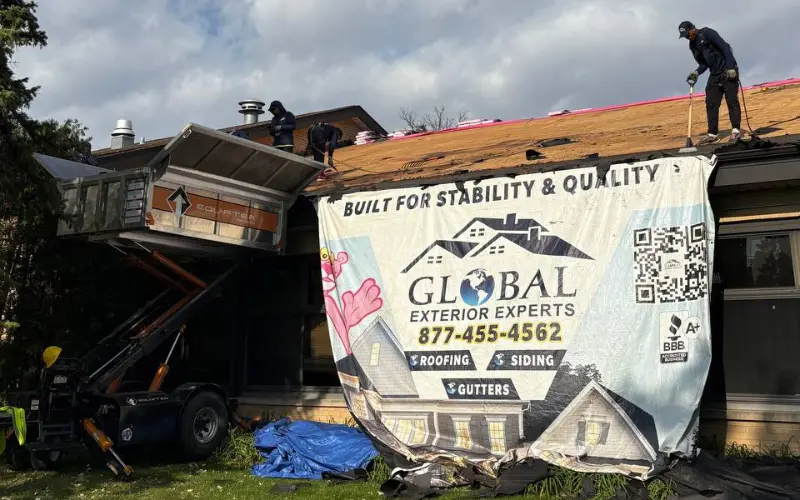Metal roofing and impact-resistant architectural shingles handle extreme weather best. Metal reflects the heat, resists wind uplift, and sheds ice easily while impact-rated shingles survive hail strikes and high winds when installed correctly. Both materials can offer proven durability in the freeze-thaw cycles, summer storms, and variable conditions common across the Midwest.
What Does Extreme Weather Mean For Your Roofing Material

Here's the thing: extreme weather isn't just about one big storm. It's the accumulation of stress over time that breaks down roofing materials and in this climate, your roof faces rapid temperature swings, ice dams in winter, severe thunderstorms with hail in spring and summer, and occasional high winds year-round.
Most roofing failures happen because the material wasn't matched to the specific stresses it would face. A roof that handles heat well might fail spectacularly when ice backs up under the shingles. Materials that resist wind might crack during freeze-thaw cycles. The best approach considers all the weather patterns your property will experience, not just the worst-case scenario.
Metal Roofing: The All-Weather Workhorse

Metal roofing stands up to extreme weather better than almost anything else. Standing seam metal panels lock together mechanically, creating a continuous barrier that wind can't penetrate. The interlocking design prevents uplift even in sustained winds above 120 mph when properly installed.
Here's what makes metal particularly effective:
- Snow and ice slide off naturally, preventing ice dam formation
- Hail impacts cause cosmetic dents but rarely compromise the roof's integrity
- Metal doesn't absorb moisture, eliminating rot and mold issues
- The material expands and contracts without cracking through temperature extremes
- Lightning strikes dissipate safely across the entire surface rather than igniting materials
Metal roof replacement typically runs $12,000 to $25,000 for an average-sized home, depending on the panel profile and gauge thickness. Installation takes 3 to 5 days under normal conditions. The material lasts 40 to 70 years with minimal maintenance, making it cost-effective despite the higher upfront investment.
One consideration: metal roofing requires specialized installation knowledge. Panels must be fastened to allow thermal movement while maintaining weathertight seals. Improper installation creates leaks at penetrations and along seams, so finding an experienced roofing company matters more with metal than with conventional materials.
Impact-Resistant Shingles: Engineered for Hail Country,

Impact-resistant architectural shingles carry a Class 4 impact rating, the highest available. These shingles feature a reinforced mat and modified asphalt formulation that absorbs impact energy without tearing or fracturing. The difference becomes obvious during hail storms when standard shingles on neighboring properties suffer damage while impact-rated roofs survive intact.
The construction uses a rubberized asphalt layer that flexes on impact rather than shattering. This flexibility also helps during freeze-thaw cycles, where conventional shingles become brittle and crack. The thicker profile (typically 30 to 50% heavier than standard shingles) provides additional wind resistance, with properly installed impact-resistant shingles rated for winds up to 130 mph.
Installation can range from $10,00 to $25,000 for roof replacement on a typical home. Many insurance companies offer premium discounts of 20 to 35% for impact-resistant roofing, which can offset the higher material cost within 5 to 8 years. The shingles typically carry warranties of 30 to 50 years, though actual lifespan depends heavily on installation quality and maintenance.
Of course, none of this comes free. Impact-resistant shingles require specific installation techniques, including strategic nail placement and proper adhesive activation. Rushing the installation or cutting corners eliminates much of the performance advantage these materials provide.
Slate and Concrete Tile: When Longevity Matters Most
.webp)
Natural slate and concrete tile offer exceptional durability in extreme weather, though they're less common due to cost and structural requirements. Slate roofs regularly last 75 to 150 years and can survive storms that destroy multiple generations of other roofing materials. The dense stone naturally resists moisture penetration, doesn't burn, and handles temperature extremes without degradation.
Concrete tile provides similar benefits at a lower price point. Modern concrete tiles include color-through formulations and improved surface treatments that resist algae growth and maintain appearance for decades. The weight and profile of concrete tile creates natural ventilation underneath, which helps manage heat buildup in summer and moisture in winter.
Both materials require substantial structural support. The weight (800 to 1,500 pounds per square for slate, 600 to 900 pounds for concrete tile) exceeds what standard roof framing can handle. Structural reinforcement adds $3,000 to $8,000 to the project cost before addressing the roofing itself.
Slate roof replacement runs $30,000 to $50,000 or more depending on the grade and thickness while concrete tile typically costs $15,000 to $30,000. Installation takes longer than other materials (7 to 14 days) and requires specialized skills and not to mention, finding qualified installers can be challenging in areas where these materials aren't common.
The upside? Properly installed slate or concrete tile roofs outlast the mortgages on the buildings they protect. Maintenance costs stay minimal, and the materials maintain their protective qualities through decades of extreme weather exposure.
Synthetic Slate and Composite Materials: Modern Engineering Meets Traditional Performance

Synthetic roofing materials replicate the appearance and performance of natural materials while reducing weight and cost. Modern polymer composites achieve Class 4 impact ratings and wind resistance comparable to metal, but weigh 75% less than natural slate. This eliminates the structural reinforcement requirement while maintaining the aesthetic of traditional materials.
Composite shingles use recycled plastics, rubber, and polymer resins engineered to resist UV degradation, impact damage, and moisture penetration. The manufacturing process creates consistent quality (unlike natural materials where every piece varies) and allows for precise weatherproofing details. Many products include built-in algae resistance and enhanced fire ratings.
Synthetic slate costs $18,000 to $35,000 for roof replacement on an average home. The materials carry warranties of 40 to 50 years, with actual performance data still accumulating since most products entered the market within the past 15 to 20 years. Installation techniques mirror conventional shingle methods, making qualified installers easier to find than for natural slate or tile.
The materials perform well in extreme weather testing, though long-term durability in real-world conditions continues to prove itself. Some early synthetic products experienced premature degradation, but current formulations show significant improvements. When choosing synthetic materials, verify the manufacturer has been producing the specific product line for at least 10 years.
Modified Bitumen and TPO for Low-Slope and Flat Roofs
Low-slope and flat roofs face different challenges than steep-slope applications. Water drains slowly or pools on the surface requiring membranes that create continuous waterproof barriers. Modified bitumen and TPO (thermoplastic polyolefin) both handle extreme weather effectively when installed correctly.
Modified bitumen uses multiple layers of reinforced asphalt membranes heat-welded together. The torch-down installation method creates seamless bonds between layers and at all penetrations. The material flexes through temperature changes without cracking and self-seals around fasteners. Modified bitumen typically lasts 15 to 25 years and can cost anywhere from $12,000 to $25,000 for roof replacement on an average commercial building or flat-roof section.
TPO membranes offer superior UV resistance and reflectivity, which reduces cooling costs in summer. The single-ply membrane gets mechanically fastened or fully adhered, with seams heat-welded to create watertight bonds. TPO resists punctures, handles temperature extremes well, and maintains flexibility over time. Expect similar costs and lifespan to modified bitumen, with specific performance advantages depending on the application.
Both systems require proper drainage design and regular maintenance. Even minor ponding water accelerates membrane degradation and eventually causes leaks. Installing tapered insulation or adjusting roof structure to ensure positive drainage adds cost but extends membrane life significantly.
Wind Uplift Resistance: Installation Matters as Much as Material
Alright, let's talk about wind damage. The materials matter, but installation determines whether your roof stays attached during severe storms. Wind uplift creates suction along roof edges, ridges, and corners, attempting to peel materials away from the deck. Poor fastening patterns or inadequate adhesive application allows this uplift to progressively separate materials until entire sections blow off.
Code requirements specify minimum attachment standards, but these represent bare minimums, not best practices. Enhanced attachment patterns (who would've thought an extra row of nails makes such a difference?) dramatically improve wind resistance. On shingle roofs, this means six nails per shingle in the perimeter zones instead of four, plus starter strip adhesion along all edges.
Metal roofing requires clips or fasteners spaced according to design wind loads, with closer spacing near edges and ridges. The attachment points must hit solid framing, not just roof decking. Missing this detail by even a few inches means fasteners pull through during uplift events.
Proper underlayment installation provides a second line of defense. Synthetic underlayments stay intact even if surface materials fail preventing water intrusion while repairs happen.
Ice Dam Prevention Through Material Selection

Ice dams form when heat escaping through the roof melts snow, which then refreezes at the eaves where the roof stays cold. The ice then backs up under shingles forcing water into the roof deck and eventually into living spaces. Material selection impacts ice dam formation significantly.
Metal roofing virtually eliminates ice dams because snow slides off before any significant melting occurs. The smooth surface and steep shedding angle prevent snow accumulation in most cases and when an ice dam does form at the eaves, it doesn't penetrate under metal panels the way it forces its way under shingles.
For shingle roofs, installing ice and water shield membrane across the entire roof deck (not just the first 3 to 6 feet required by code) provides comprehensive protection. The self-sealing membrane prevents water penetration even when ice dams form. The upgrade can be quite costly depending on roof size but eliminates a major source of weather-related damage.
Proper attic ventilation and insulation matter more than material selection for preventing ice dams. Ridge vents, soffit vents, and adequate insulation keep the roof deck cold, preventing the melt-refreeze cycle. Many roof replacement projects need ventilation improvements to achieve reliable ice dam prevention and be up to code.
What to Consider Before Your Roof Replacement Project
Building permits and inspections add time and cost but ensure proper installation.
The permit process normally takes 1 to 3 weeks in most areas, sometimes longer during busy seasons but starting work without permits risks fines, complicates insurance claims, and creates problems when selling the property. Any reputable roofing company handles permits as part of their service.
Material availability affects project timing, especially for specialty products. Standard shingles ship within days while metal roofing might require 2 to 6 weeks for fabrication. Slate, tile, and some synthetic materials have lead times of 4 to 8 weeks. Plan accordingly rather than rushing into available materials that don't meet your performance requirements.
Check contractor credentials carefully. Verify licensing (where required), insurance coverage including workers compensation, and manufacturer certifications for the materials you're considering. Ask for references from projects completed 3 to 5 years ago, which shows long-term performance rather than just initial installation quality. The cheapest bid often signals cut corners that compromise weather resistance.
Final Thoughts: Choosing Materials That Match Your Needs
The best roofing material for extreme weather depends on your specific situation: budget, building structure, aesthetic preferences, and the particular weather challenges your property faces. Metal roofing offers the most comprehensive protection across all weather types but requires higher upfront investment. Impact-resistant shingles provide excellent performance at moderate cost. Premium materials like slate or concrete tile make sense for long-term ownership when structural support allows.
Focus on proper installation as much as material selection. The best materials fail when installed incorrectly, while even conventional materials perform well when installation follows best practices. Work with an experienced roofing company that understands local weather patterns and building codes.
Consider the complete cost picture including insurance savings, maintenance requirements, and expected lifespan. The cheapest initial option often costs more over time through premature failures, higher maintenance, and increased energy costs.
Start by getting detailed quotes from multiple contractors using the materials you're considering. Ask specific questions about attachment methods, underlayment options, ventilation improvements, and warranty coverage. The answers reveal which contractors understand extreme weather roofing and which ones are just selling products.
Your roof protects everything inside the building. Investing in materials and installation that handle extreme weather reliably pays off through decades of dependable service and peace of mind during severe storms.

.webp)
.webp)
.webp)
